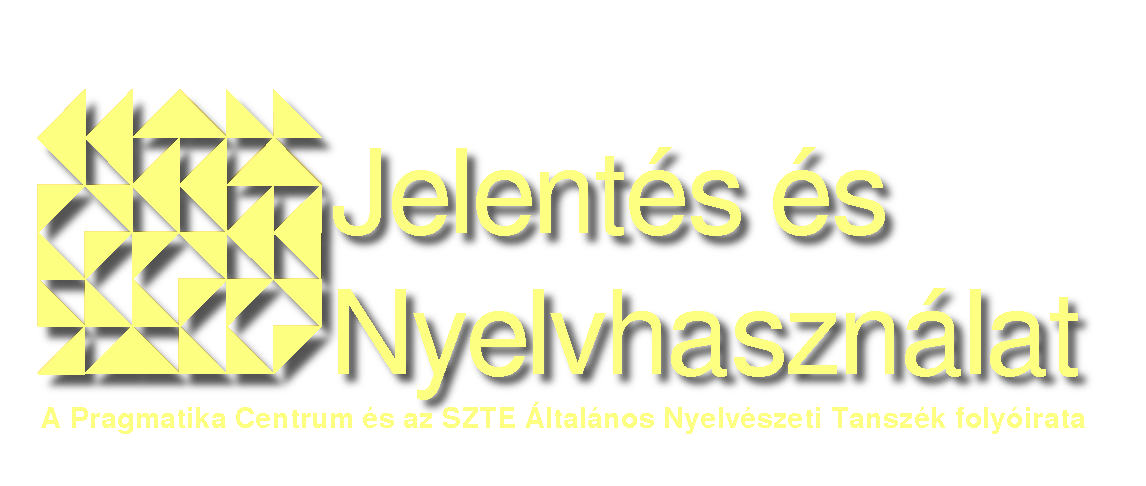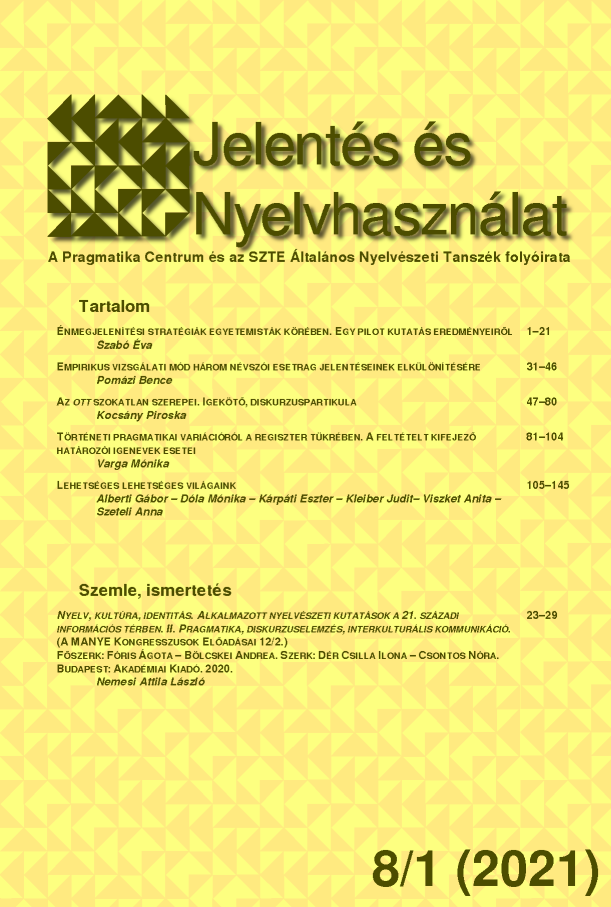Lehetséges lehetséges világaink
Main Article Content
Absztrakt
A ℜeALIS reprezentacionalista gyökereinek felvázolását és a kurrens dinamikus-pragmatikai célrendszer (Farkas–Roelofsen 2017) feltérképezését követően azt az adósságot kívánjuk törleszteni, hogy a kérdő mondattípus pragmaszemantikai jellemzéséhez hasonló alaposságú leírást (Alberti et al. 2019a) kapjon a felkiáltó és az óhajtó, valamint a felszólító és a kijelentő mondat is. E mondattípusok pragmaszemantikai jellemzésének finom részleteivel kívánunk szolgálni, végső soron az emberi kommunikációs tevékenység mentális megalapozását jelentő elmebeli lehetségesvilág-struktúra feltérképezéséhez járulva hozzá. Azt is szemléltetjük, hogy a diskurzusjelölők hogyan vonnak be újabb világokat e mentális térbe. Végül (az addigi feladói perspektíva helyett) a címzetti perspektívából vesszük szemügyre a hallgatói perlokúciós műveletek révén tovább gyarapodó „lehetséges lehetséges világainkat”.
Letöltések
Article Details

This work is licensed under a Creative Commons Attribution-NonCommercial-NoDerivatives 4.0 International License.
Hivatkozások
Alberti, Gábor 2000. Lifelong discourse representation structures. Gothenburg Papers in Computational Linguistics 00–5:13–20.
Alberti, Gábor 2008. Situations and Individuals by Paul D. Elbourne, review article. Acta Linguistica Hungarica 55/3–4:427–453. doi: https://doi.org/10.1556/aling.55.2008.3-4.14
Alberti Gábor 2011. ℜeALIS. Interpretálók a világban, világok az interpretálóban. Budapest: Akadémiai Kiadó.
Alberti, Gábor 2012. Where are possible worlds? II. Pegs, DRSs, worldlets and reification. In Alberti Gábor – Farkas Judit – Kleiber Judit (szerk.) Vonzásban és változásban. Pécs: PTE Nyelvtudományi Doktori Iskola. 308–323.
Alberti Gábor – Dóla Mónika – Kárpáti Eszter – Kleiber Judit – Szeteli Anna – Viszket Anita 2019a. Kérdéses világaink. Jelentés és Nyelvhasználat 6/2:11–35. doi: https://doi.org/10.14232/JENY.2019.2.3
Alberti, Gábor – Mónika Dóla – Eszter Kárpáti – Judit Kleiber – Anna Szeteli – Anita Viszket 2019b. Towards a cognitively viable linguistic representation. Argumentum 15:62–80.
Alberti, Gábor – Mónika Dóla – Judit Kleiber 2014. Mood and modality in Hungarian: Discourse Representation Theory meets Cognitive Linguistics. Argumentum 10:172–191.
Alberti, Gábor – Judit Kleiber 2012. Where are possible worlds? (Arguments for ℜeALIS). Acta Linguistica Hungarica 59/1–2:3–26. doi: https://doi.org/10.1556/ALing.59.2012.1-2.1
Alberti, Gábor – Judit Kleiber 2014. ℜeALIS: Discourse representation with a radically new ontology. In Ludmila Veselovská – Markéta Janebová (szerk.) Complex Visibles Out There. Proceedings of the Olomouc Linguistics Colloquium 2014: Language Use and Linguistic Structure. (Olomouc Modern Language Monographs 4) Olomouc: Palacký University. 513–528.
Alberti Gábor – Kleiber Judit – Kárpáti Eszter 2017. Reális (ℜeALIS) kép a másik elméjéről. In Márton Miklós – Molnár Gábor – Tőzsér János (szerk.) Más elmék. Budapest: L’Harmattan Kiadó. 237–268.
Alberti, Gábor – Judit Kleiber – Zsuzsanna Schnell – Veronika Szabó 2016. Intensional profiles and different kinds of human minds. „Case studies” about Hungarian imperative-like sentence types. LingBaW (Linguistics Beyond and Within) 2:6–26.
Alberti, Gábor – Tibor Laczkó (szerk.) 2017. Syntax of Hungarian. Nouns and Noun Phrases. Vol. 2 Amsterdam: Amsterdam University Press.
Alberti, Gábor – László Nőthig 2015. ℜeALIS2.1: The implementation of generalized intensional truth tvaluation and expositive speech acts in on-going discourse. International Journal on Advances in Intelligent Systems 8/1–2:85–106.
Alberti Gábor – Szeteli Anna 2018. ℜeALIS: a mi kölcsönös és élethossziglani tudásunk. Iskolakultúra 28/5–6:3–14. doi: https://doi.org/10.17543/ISKKULT.2018.5-6.3
Austin, John Langshaw 1975 [1962]. How To Do Things With Words. Oxford: Oxford University Press.
Barwise, Jon – John Perry 1983. Situations and Attitudes. Cambridge: The MIT Press.
Beaver, David Ian 1997. Presupposition. In Johan van Benthem – Alice ter Meulen (szerk.) Handbook of Logic and Language. Amsterdam: North-Holland. 939–1008. doi: https://doi.org/10.1016/B978-044481714-3/50022-9
Broekhuis, Hans – Evelin Keizer – Marcel den Dikken 2012. Syntax of Dutch – Nouns and Noun Phrases. Amsterdam: Amsterdam University Press.
Ciardelli, Ivano – Jeroen Groenendijk – Floris Roelofsen 2013. Inquisitive semantics: A new notion of meaning. Language and Linguistics Compass 7/9:459–476. doi: https://doi.org/10.1111/lnc3.12037
Dowty, David R. – Robert E. Wall – Stanley Peters 1981. Introduction to Montague Semantics. (Studies in Linguistics and Philosophy 11) Dordrecht: Reidel.
Elbourne, Paul D. 2005. Situations and Individuals. (Current Studies in Linguistics) Cambridge: The MIT Press.
Farkas, Judit – Magdolna Ohnmacht 2012. Aspect and eventuality structure in a representational dynamic semantics. In Alberti Gábor – Farkas Judit – Kleiber Judit (szerk.) Vonzásban és változásban. Pécs: PTE Nyelvtudományi Doktori Iskola. 353–379.
Farkas, Donka F. – Floris Roelofsen 2017. Division of labor in the interpretation of declaratives and interrogatives. Journal of Semantics 34/2:237–289. doi: https://doi.org/10.1093/jos/ffw012
Field, Andy P. 2013. Discovering Statistics Using IBM SPSS Statistics. And Sex and Drugs and Rock ‘n’ roll. 4th edition. Los Angeles: Sage.
Fischer, Kerstin 2006. Towards an understanding of the spectrum of approaches to discourse particles: Introduction to the volume. In Kerstin Fischer (szerk.) Approaches to Discourse Particles. Amsterdam: Elsevier. 1–20. doi: https://doi.org/10.1163/9780080461588_002
Gärtner, Hans-Martin – Beáta Gyuris 2012. Pragmatic markers in Hungarian: Some introductory remarks. Acta Linguistica Hungarica 59/4:387–426. doi: https://doi.org/10.1556/ALing.59.2012.4.1
Givón, Talmy 1982. Evidentiality and epistemic space. Studies in Language 6/1:23–49. doi: https://doi.org/10.1075/sl.6.1.03giv
Grice, H. Paul 1975. Logic and conversation. In Peter Cole – Jerry L. Morgan (szerk.) Syntax and Semantics Vol. 3. Speech Acts. New York: Academic Press. 41–58.
Groenendijk, Jeroen – Martin Stokhof 1991. Dynamic predicate logic. Linguistics and Philosophy 14/1:39–100. doi: https://doi.org/10.1007/BF00628304
Gunlogson, Christine 2008. A question of commitment. Belgian Journal of Linguistics 22:101–136. doi: https://doi.org/10.1075/bjl.22.06gun
Gyuris Beáta 2013. Megjegyzések a pragmatika tárgyáról és hasznáról. Magyar Nyelv 109/2:162–170.
Horn, Laurence R. 1984. Towards a new taxonomy of pragmatic inference: Q-based and R-based implicatures. In Deborah Schiffrin (szerk.) Meaning, Form, and Use in Context: Linguistic Applications. Washington: Georgetown University Press. 11–42.
Kálmán, László 1990. Deferred information: The semantics of commitment. In László Kálmán – László Pólos (szerk.) Papers from the Second Symposium on Logic and Language. Budapest: Akadémiai Kiadó. 125–157.
Kamp, Hans 1981. A theory of truth and semantic representation. In Jeroen A. G. Groenendijk – Theo M. V. Janssen – Martin B. J. Stokhof (szerk.) Formal Methods in the Study of Language. Amsterdam: Mathematisch Centrum. 277–322.
Kamp, Hans – Josef van Genabith – Uwe Reyle 2011. Discourse representation theory. In Dov M. Gabbay – Franz Guenthner (szerk.) Handbook of Philosophical Logic: Volume 15. 2. kiad. Berlin: Springer. 125–394.
Kas Bence 2005. Az óhajtó mondatok kategóriája. Nyelvtudományi Közlemények 102:136–174.
Kleiber, Judit 2018. Similar intentions with different underlying wishes: Intensional profiles of imperatives in Hungarian. Jezikoslovlje 19/3:365–391.
Kugler Nóra 2012. Az evidencialitás jelölői a magyarban, különös tekintettel az inferenciális evidenciatípusra. Budapest: ELTE.
Lauer, Sven 2013. Towards a Dynamic Pragmatics. PhD disszertáció. Stanford: Stanford University.
Leiss, Judit 2014. Modes of modality in an Un-Cartesian framework. In Sibilla Cantarini – Werner Abraham – Elisabeth Leiss (szerk.) Certainty-uncertainty – and the Attitudinal Space in Between. (Studies in Language Companion Series 165) Amsterdam: John Benjamins Publishing Company. 47–62. doi: https://doi.org/10.1075/slcs.165.03lei
Maier, Emar 2009. Presupposing acquaintance: A unified semantics for de dicto, de re and de se belief reports. Linguistics and Philosophy 32/5:429–474. doi: https://doi.org/10.1007/s10988-010-9065-2
Maier, Emar 2016. Attitudes and mental files in Discourse Representation Theory. Review of Philosophy and Psychology 7/2:473–490. doi: https://doi.org/10.1007/s13164-015-0296-6
Nőthig László – Szeteli Anna 2018. Nagyfelbontású pragmaszemantikai igazságértékelés egy játékprogramban. In Vincze Veronika (szerk.) MSZNY 2018. XIV. Magyar Számítógépes Nyelvészeti Konferencia. Szeged: Szegedi Tudományegyetem, Informatikai Intézet. 456–465.
Oishi, Etsuko 2014. Discursive functions of evidentials and epistemic modals. In Sibilla Cantarini – Werner Abraham – Elisabeth Leiss (szerk.) Certainty-uncertainty – and the Attitudinal Space in Between. (Studies in Language Companion Series 165) Amsterdam: John Benjamins Publishing Company. 239–262. doi: https://doi.org/10.1075/slcs.165.14ois
Oishi, Etsuko 2016. Austin’s speech acts and Mey’s pragmemes. In Keith Allan – Alessandro Capone – Istvan Kecskes (szerk.) Pragmemes and Theories of Language Use. (Perspectives in Pragmatics, Philosophy & Psychology) Berlin: Springer. 335–350. doi: https://doi.org/10.1007/978-3-319-43491-9_18
Partee, Barbara H. – Alice Ter Meulen – Robert E. Wall 1990. Mathematical Methods in Linguistics. (Studies in Linguistics and Philosophy 30) Dordrecht: Kluwer Academic Publishers.
Pollard, Carl 2007. Hyperintensions. Előadás. 19th European Summer School in Logic, Language and Information. Trinity College, Dublin. https://tinyurl.com/jeny-pollard-2007
Rákosi Csilla 2020. Foundational Quandaries in Cognitive Linguistics: Uncertainty, Inconsistency, and the Evaluation of Theories. Akadémiai doktori értekezés. MTA-DE-SZTE Elméleti Nyelvészeti Kutatócsoport.
Roberts, Craige 1997. Anaphora in intensional contexts. In Shalom Lappin (szerk.) The Handbook of Contemporary Semantic Theory. Oxford: Blackwell. 215–246.
Sadock, Jerrold – Arnold Zwicky 1985. Speech act distinctions in syntax. In Timothy Shopen (szerk.) Language Typology and Syntactic Description. Cambridge: Cambridge University Press. 155–196.
Schirm Anita 2011. A diskurzusjelölők funkciói: a hát, az -e és a vajon elemek története és jelenkori szinkrón státusa alapján. Doktori értekezés. Szeged: Szegedi Tudományegyetem. https://tinyurl.com/jeny-schirm-2011
Schult, Carolyn A. 2002. Children’s understanding of the distinction between intentions and desires. Child Development 73/6:1727–1747.
Searle, John R. 1969. Speech Acts: An Essay in the Philosophy of Language. Cambridge: Cambridge University Press.
Searle, John R. 1976. A classification of illocutionary acts. Language in Society 5/1:1–23.
Seligman, Jerry – Lawrence S. Moss 1997. Situation theory. In Johan van Benthem – Alice ter Meulen (szerk.) Handbook of Logic and Language. London: Elsevier. 239–309.
Stalnaker, Robert 2002. Common ground. Linguistics and Philosophy 25/5:701–721. doi: https://doi.org/10.1023/A:1020867916902
Szeteli Anna 2017. Szerint(em). A kifejezés funkcióinak vizsgálata formális interpretációs rendszerben. In Böhm Gábor – Czeferner Dóra – Fedeles Tamás (szerk.) Szemelvények 4. Válogatás a PTE BTK XXXIII. Országos Tudományos Diákköri Konferencián (2017) I–III. helyezést elért hallgatóinak pályaműveiből. Pécs: PPKE BTK. 88–107.
Szeteli Anna 2021. Az inferencialitás és a közvetlen tapasztalat – Beszélői „visszaélések” a szerintem kifejezés tükrében. OTDK dolgozat.
Szeteli, Anna – Mónika Dóla – Gábor Alberti 2019. Pragmasemantic analysis of the Hungarian inferential-evidential expression szerint. Studies in Polish Linguistics Special Issue 1:207–225. doi: https://doi.org/10.4467/23005920SPL.19.013.10993
Szeteli Anna – Gocsál Ákos – Alberti Gábor 2019. Szemafor hát! Jelentés és Nyelvhasználat 6/1:33–63. doi: https://doi.org/10.14232/jeny.2019.1.2
Szeteli Anna – Kárpáti Eszter 2021. Parancsolsz? Mondattípus, illokúciós aktus, perlokúciós hatás. Kézirat. PTE Nyelvtudományi Tanszék. https://tinyurl.com/jeny-szeteli-karpati-2019
Tulving, Endel 2005. Episodic memory and autonoesis: Uniquely human? In Herbert S. Terrace – Janet Metcalfe (szerk.) The Missing Link in Cognition: Origins of Self-reflective Consciousness. Oxford: Oxford University Press. 3–56. doi: https://doi.org/10.1093/acprof:oso/9780195161564.003.0001
Wimmer, Heinz – Josef Perner 1983. Beliefs about beliefs: Representation and constraining function of wrong beliefs in young children’s understanding of deception. Cognition 13/1:103–128. doi: https://doi.org/10.1016/0010-0277(83)90004-5

